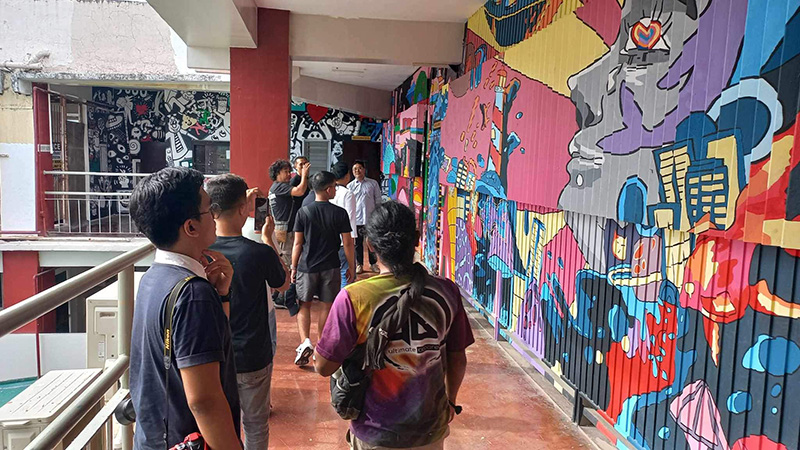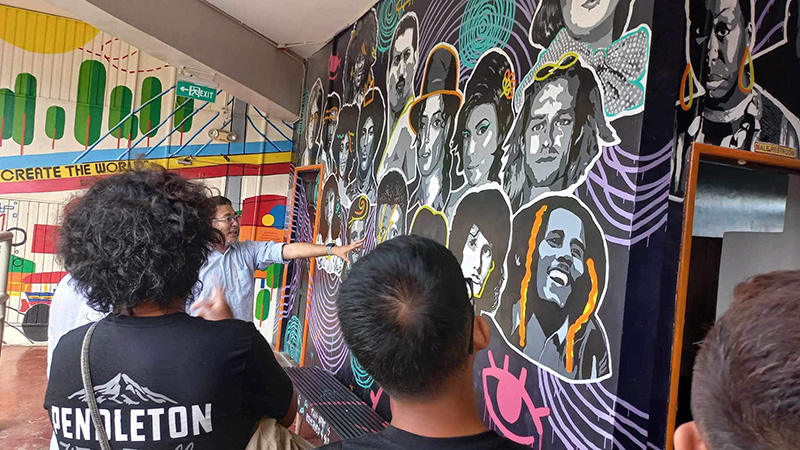
Promoting Social Change through Public Art
by Gieperl Hann Largo
Public art installations can take many forms—from murals to sculptures to performance art. They bring life to a public space, function as a landmark, and engage the public. Public art is a powerful tool to make art more accessible. This is why Cebuano fashion designer and visionary Edwin Ao is drawn to it, and he wants to use it to promote social change.
Edwin Ao is a self-taught abstract artist who creates aesthetically intriguing and emotionally resonant paintings. His art is influenced by his passions for fashion, travel, and the human experience.
He started his journey in art as a fashion designer. He attended the University of San Carlos in Cebu City where he studied design fundamentals such as proportion, balance, and color theory. His artistic skills have served him well in his paintings, as he frequently employs them to create compositions that are both visually appealing and thought-provoking.
His paintings are more than just works of art. They additionally reflect his point of view about the world. His work exemplifies the capacity of art to convey complicated emotions and concepts in a visually appealing manner.
One-of-a-kind Educator
Edwin Ao is an enthusiastic educator in addition to being a painter. Since 2006, he has been teaching painting and handling the course subject of arts and design at the Cebu Institute of Technology-University (CIT-U). He considers it essential to pass on his knowledge and skills to the next generation of artists. He is dedicated and passionate about supporting his students in developing their unique artistic voices.
Wall of Art
Imagine walking in a hallway filled with paintings. Each one is as spectacular as the next. Surely, you would stop and gaze at the paintings momentarily, appreciating their beauty.
That’s how Edwin Ao envisioned it to be when he rallied his students to create the “wall of art” in CIT-U, leaving a lasting impact on those who encounter it.

Guests and members of the press at the Mural Walk tour event at Cebu Institute of Technology-University. (Photo by Carl Vincent Rabor, 2023)
“It will make your head turn and make you gaze at the paintings even if you are doing something,” he said.
Under his direction and leadership, his students under the Bachelor of Fine Arts in Multimedia (BMMA) program produced the MMA226 Street Art Murals. The concept of the mural paintings was intended as a final output for the class about street art. The class was divided into six groups, and each of them had to interpret the murals as a landmark or a place-to-go theme. Numerous subjects are represented in the murals, such as social messages, cultural icons, and local landmarks. They are vivid and colorful and have already established themselves as a recognizable part of the university’s campus.
The MMA226 Street Art Murals have made a significant difference in the school. They have improved the campus’s aesthetic appeal and contributed to making it feel more vibrant and more welcoming. On top of that, it aided in fostering a sense of community and social cohesiveness. The mural paintings on the fourth floor of the RTL Building are now a popular spot for students to gather and mingle.

Edwin Ao explains the inspiration behind one of the murals at the Mural Walk tour event. (Photo by Carl Vincent Rabor, 2023)
The murals have also contributed to greater public awareness of the BMMA program. Since the murals were painted, the program’s enrollment has grown significantly.
“Many students enrolled in CIT-U because they feel the presence of the art community on campus,” Edwin Ao added.
Not everyone knew that the BMMA program existed; however, with the power of social media, it became known, not just inside the CIT-U but also outside the campus. Because of the “wall of art,” it has piqued the interest of young people who eventually enrolled at CIT-U.
Role of Government
Edwin Ao has always been a staunch advocator of public art. He believes art can improve urban landscapes and promote social change. He expressed that the government must also come in and support the public art installation for it will benefit the city immensely.
“Government must be involved and must play an important role. There are a lot of brilliant artists out there waiting to be discovered,” he surmised.
He also shared his point of view for artists who are interested in making public art installations:
“If you want to create, do it now. Do it right away. Every minute is important. The world is very competitive. You need to make the opportunity happen.”
